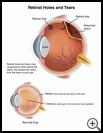
Retinal Holes and Tears
________________________________________________________________________
KEY POINTS
- Retinal holes and tears are small breaks in the retina, which is the lining at the back of your eye that senses light coming into your eye. Retinal holes and tears may cause fluid to leak behind the retina, and detach the retina from the back of your eye. This can lead to blindness and must be treated promptly.
- Your provider will seal the retinal holes and tears so that they do not get bigger, fluid does not get underneath the retina, and the retina does not detach. This may be done with a laser, or a tool to freeze the tissue in place. You may be prescribed eye drops.
________________________________________________________________________
What are retinal holes and tears?
Retinal holes and tears are small breaks in the retina, which is the lining at the back of your eye that senses light coming into your eye. Usually holes and tears do not mean you will have serious vision problems right away. However, retinal holes and tears may cause fluid from the center of your eyeball to leak behind the retina. If enough fluid gets behind the retina, the retina can separate from the back of your eye. The detached part of the retina will not work properly. Detachment of the retina is a serious condition that can lead to blindness and must be treated promptly to save your vision.
What is the cause?
The gel (vitreous) in the center of your eyeball is usually clear and smooth. With age, pockets of fluid can develop in the gel, and cause it to pull away from the retina. This happens to everyone over time, and is not harmful. However, sometimes the gel pulls on a thin or weak area of the retina, and causes a tear or hole. Problems that may increase your risk of retinal holes and tears include:
- Nearsightedness
- Eye injuries
- Cataract or certain other types of eye surgery
- A history of retinal holes or tears in your other eye
- Health problems such as sickle cell disease or diabetes
- Other people in your family who have had retinal problems
What are the symptoms?
Sometimes retinal holes and tears have no symptoms. However, if you suddenly see floaters, which are dark spots or squiggles in your vision, or flashes, which are flickers or arcs of light in your side vision, you may have a hole or tear. Symptoms of a larger retinal tear or retinal detachment may include:
- Cloudy, blurry, or wavy vision
- A dark shadow or curtain in your vision
How are they diagnosed?
Your eye care provider will ask about your symptoms and medical history and do exams and tests such as:
- An exam using a microscope with a light attached, called a slit lamp, to look closely at the front and back of your eye
- An exam using drops to enlarge, or dilate, your pupils and a light to look into the back of your eyes
- An ultrasound, which uses sound waves to show pictures of the back of your eye
How are they treated?
The purpose of treatment is to prevent a retinal detachment. Your provider will seal the retinal holes and tears so that they do not get bigger, fluid does not get underneath the retina, and the retina does not detach. This may be done using a laser, or using a tool called a cryoprobe to freeze the tissue in place. You may be prescribed eye drops.
Rarely, retinal holes do not need treatment, but should be checked regularly.
Treatments for retinal holes and tears are usually successful. However, the holes or tears do not seal completely at the time of the treatment. Because of this, there is a small risk that the problem will progress to a retinal detachment before the holes have healed. Your retina specialist may tell you not to do anything strenuous for the first week after treatment.
How can I take care of myself?
Follow the full course of treatment your healthcare provider prescribes. Ask your healthcare provider:
- How and when you will get your test results
- How long it will take to recover
- If there are activities you should avoid and when you can return to your normal activities
- How to take care of yourself at home
- What symptoms or problems you should watch for and what to do if you have them
Make sure you know when you should come back for a checkup. Keep all appointments for provider visits or tests.
How can I help prevent retinal holes and tears?
Other than protecting your eyes from injury, there is no way to prevent retinal holes and tears. However, you can help prevent blindness if you see your eye care provider for regular checkups or as soon as you have symptoms of holes or tears.
Have your eyes examined regularly and tell all eye care providers that you have had retinal problems. There is a chance that you will have a retinal hole or tear in another part of your eye later.

